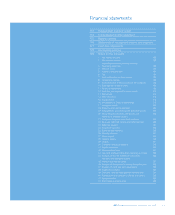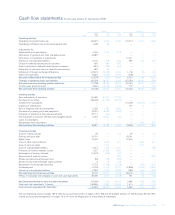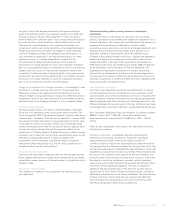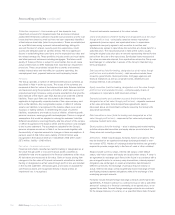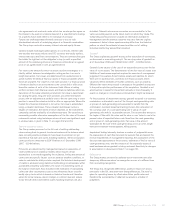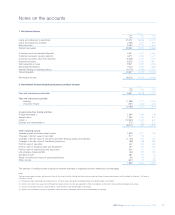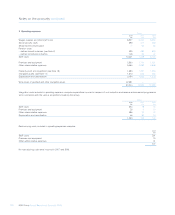RBS 2008 Annual Report Download - page 182
Download and view the complete annual report
Please find page 182 of the 2008 RBS annual report below. You can navigate through the pages in the report by either clicking on the pages listed below, or by using the keyword search tool below to find specific information within the annual report.
181RBS Group Annual Report and Accounts 2008
11. Leases
Contracts to lease assets are classified as finance leases if they transfer
substantially all the risks and rewards of ownership of the asset to the
customer. Other contracts to lease assets are classified as operating
leases.
Finance lease receivables are stated in the balance sheet at the amount
of the net investment in the lease being the minimum lease payments
and any unguaranteed residual value discounted at the interest rate
implicit in the lease. Finance lease income is allocated to accounting
periods so as to give a constant periodic rate of return before tax on the
net investment. Unguaranteed residual values are subject to regular
review to identify potential impairment. If there has been a reduction in
the estimated unguaranteed residual value, the income allocation is
revised and any reduction in respect of amounts accrued is recognised
immediately.
Rental income from operating leases is credited to the income
statement on a receivable basis over the term of the lease. Operating
lease assets are included within Property, plant and equipment and
depreciated over their useful lives (see accounting policy 7).
12. Insurance
General insurance
General insurance comprises short-duration contracts, principally
property and liability insurance contracts. Due to the nature of the
products sold – retail-based property and casualty, motor, home and
personal health insurance contracts – the insurance protection is
provided on an even basis throughout the term of the policy.
Premiums from general insurance contracts are recognised in the
accounting period in which they begin. Unearned premiums represent
the proportion of the net premiums that relate to periods of insurance
after the balance sheet date and are calculated over the period of
exposure under the policy, on a daily basis, 24th’s basis or allowing for
the estimated incidence of exposure under policies which are longer
than twelve months. Provision is made where necessary for the
estimated amount of claims over and above unearned premiums
including that in respect of future written business on discontinued lines
under the run-off of delegated underwriting authority arrangements. The
provision is designed to meet future claims and related expenses and is
calculated across related classes of business on the basis of a
separate carry forward of deferred acquisition expenses after making
allowance for investment income.
Acquisition expenses relating to new and renewed business for all
classes are expensed over the period during which the premiums are
earned. The principal acquisition costs so deferred are commissions
payable, costs associated with the telesales and underwriting staff and
prepaid claims handling costs in respect of delegated claims handling
arrangements for claims which are expected to occur after the balance
sheet date. Claims and the related reinsurance are recognised in the
accounting period in which the loss occurs. Provision is made for the full
cost of settling outstanding claims at the balance sheet date, including
claims estimated to have been incurred but not yet reported at that
date, and claims handling expenses. The related reinsurance receivable
is recognised at the same time.
Life assurance
The Group’s long-term assurance contracts include whole-life term
assurance, endowment assurance, flexible whole-life, pension and
annuity contracts that are expected to remain in force for an extended
period of time. Long-term assurance contracts under which the Group
does not accept significant insurance risk are classified as financial
instruments.
The Group recognises the value of in-force long-term assurance
contracts as an asset. Cash flows associated with in-force contracts and
related assets, including reinsurance cash flows, are projected, using
appropriate assumptions as to future mortality, persistency and levels of
expenses and excluding the value of future investment margins, to
estimate future surpluses attributable to the Group. These surpluses,
discounted at a risk-adjusted rate, are recognised as a separate asset.
Changes in the value of this asset are included in profit or loss.
Premiums on long-term insurance contracts are recognised as income
when receivable. Claims on long-term insurance contracts reflect the
cost of all claims arising during the year, including claims handling
costs. Claims are recognised when the Group becomes aware of the
claim.
Reinsurance
The Group has reinsurance treaties that transfer significant insurance
risk. Liabilities for reinsured contracts are calculated gross of
reinsurance and a separate reinsurance asset recorded.
13. Provisions
The Group recognises a provision for a present obligation resulting from
a past event when it is more likely than not that it will be required to
transfer economic benefits to settle the obligation and the amount of the
obligation can be estimated reliably.
Provision is made for restructuring costs, including the costs of
redundancy, when the Group has a constructive obligation to
restructure. An obligation exists when the Group has a detailed formal
plan for the restructuring and has raised a valid expectation in those
affected by starting to implement the plan or announcing its main
features.
If the Group has a contract that is onerous, it recognises the present
obligation under the contract as a provision. An onerous contract is one
where the unavoidable costs of meeting the obligations under it exceed
the expected economic benefits. When the Group vacates a leasehold
property, a provision is recognised for the costs under the lease less
any expected economic benefits (such as rental income).
Contingent liabilities are possible obligations arising from past events
whose existence will be confirmed only by uncertain future events or
present obligations arising from past events that are not recognised
because either an outflow of economic benefits is not probable or the
amount of the obligation cannot be reliably measured. Contingent
liabilities are not recognised but information about them is disclosed
unless the possibility of any outflow of economic benefits in settlement
is remote.


